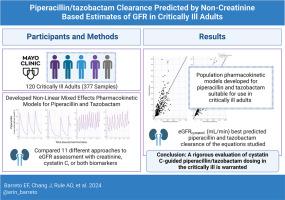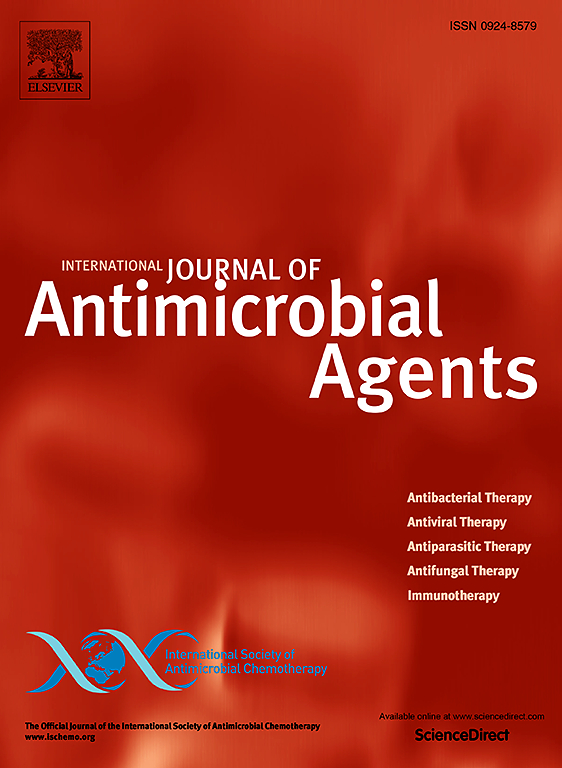Piperacillin/tazobactam clearance predicted by non-creatinine based estimates of GFR in critically ill adults
IF 4.6
2区 医学
Q1 INFECTIOUS DISEASES
International Journal of Antimicrobial Agents
Pub Date : 2025-08-05
DOI:10.1016/j.ijantimicag.2025.107586
引用次数: 0
Abstract
Background and objective
As a renally-eliminated beta-lactam antibiotic, estimated glomerular filtration rate (eGFR) is a central component of piperacillin/tazobactam pharmacokinetics. This study aimed to determine the optimal eGFR equation for inclusion in population pharmacokinetic models for piperacillin and tazobactam among critically ill adults.
Methods
The study included critically ill adults treated with piperacillin/tazobactam at a single academic medical center between 2018 and 2022. Excluded individuals had acute kidney injury, received kidney replacement therapy, or had extracorporeal membrane oxygenation at piperacillin/tazobactam initiation. Non-linear mixed effects population pharmacokinetic models using eGFR equations with creatinine, cystatin C, or both were developed and compared.
Results
Using 377 samples from 120 critically ill patients, we found that a two-compartment model with first-order elimination best fit the piperacillin data and a one-compartment model with first-order elimination best fit the tazobactam data. For piperacillin, the final population mean parameters (standard error) were 8.36 (0.55) L/h for CL and 12.96 (1.17) L for V1. The values for Q and V2 were fixed at 0.98 L/h and 18 L, respectively, due to low interindividual variation in these parameters. For tazobactam, the final population mean parameters were 8.12 (0.52) L/h for CL and 16.87 (1.44) L for V. Both final models identified eGFRcystatinC expressed in mL/min as the eGFR equation that best predicted drug clearance as a covariate.
Conclusions
An eGFR equation that includes cystatin C improves the predictive performance of pharmacokinetic models for piperacillin/tazobactam in critically ill adults.

危重成人非肌酐GFR预测哌拉西林/他唑巴坦清除率
背景和目的:作为一种肾消除的β -内酰胺类抗生素,估计的肾小球滤过率(eGFR)是哌西林/他唑巴坦药代动力学的核心组成部分。本研究旨在确定纳入危重成人哌拉西林和他唑巴坦群体药代动力学模型的最佳eGFR方程。方法:该研究纳入2018年至2022年在单一学术医疗中心接受哌拉西林/他唑巴坦治疗的危重成人。排除的个体有急性肾损伤,接受肾脏替代治疗,或在哌拉西林/他唑巴坦开始时进行体外膜氧合。利用eGFR方程与肌酐、胱抑素C或两者结合建立了非线性混合效应群体药代动力学模型并进行了比较。结果:通过对120例危重患者的377份样本进行分析,我们发现一阶消除的两室模型最适合哌拉西林数据,一阶消除的一室模型最适合他唑巴坦数据。哌拉西林的最终总体平均参数(标准误差)CL为8.36 (0.55)L/h, V1为12.96 (1.17)L。由于个体间差异较小,Q和V2的值分别固定在0.98 L/h和18 L。对于他唑巴坦,最终群体平均参数CL为8.12 (0.52)L/h, v为16.87 (1.44)L。两个最终模型都确定以mL/min表达的eGFRcystatinC是最能预测药物清除率的eGFR方程。结论:包含胱抑素C的eGFR方程提高了危重成人哌拉西林/他唑巴坦药代动力学模型的预测性能。
本文章由计算机程序翻译,如有差异,请以英文原文为准。
求助全文
约1分钟内获得全文
求助全文
来源期刊
CiteScore
21.60
自引率
0.90%
发文量
176
审稿时长
36 days
期刊介绍:
The International Journal of Antimicrobial Agents is a peer-reviewed publication offering comprehensive and current reference information on the physical, pharmacological, in vitro, and clinical properties of individual antimicrobial agents, covering antiviral, antiparasitic, antibacterial, and antifungal agents. The journal not only communicates new trends and developments through authoritative review articles but also addresses the critical issue of antimicrobial resistance, both in hospital and community settings. Published content includes solicited reviews by leading experts and high-quality original research papers in the specified fields.

 求助内容:
求助内容: 应助结果提醒方式:
应助结果提醒方式:


